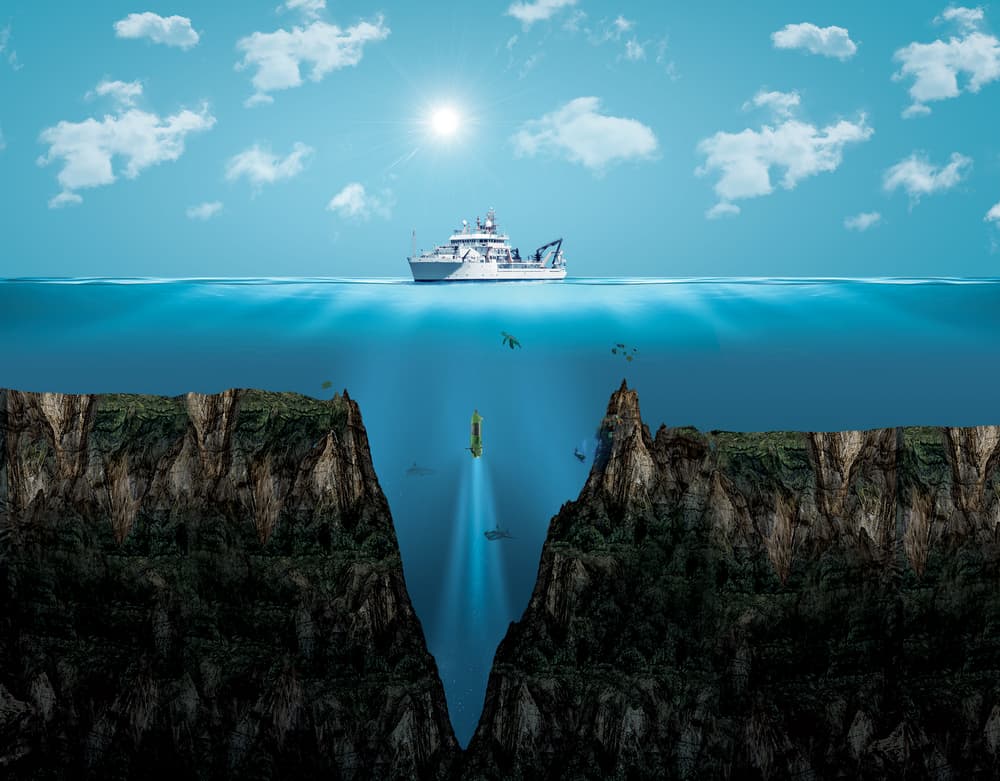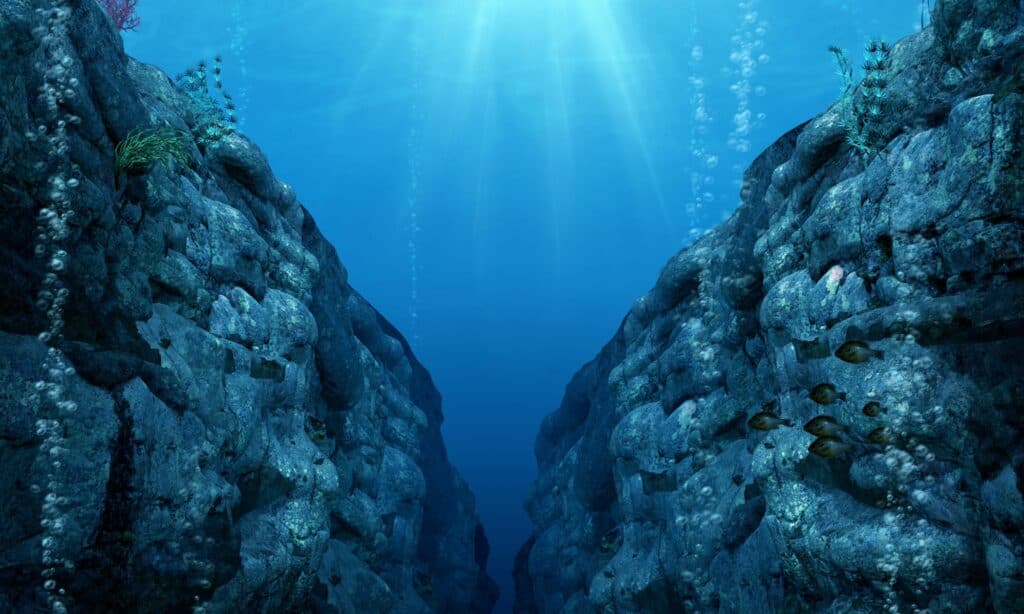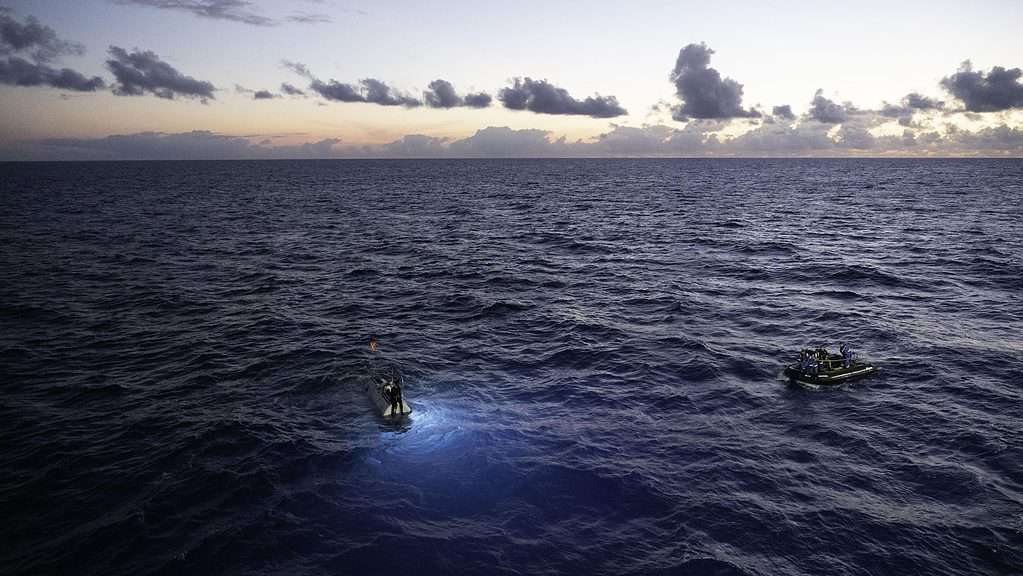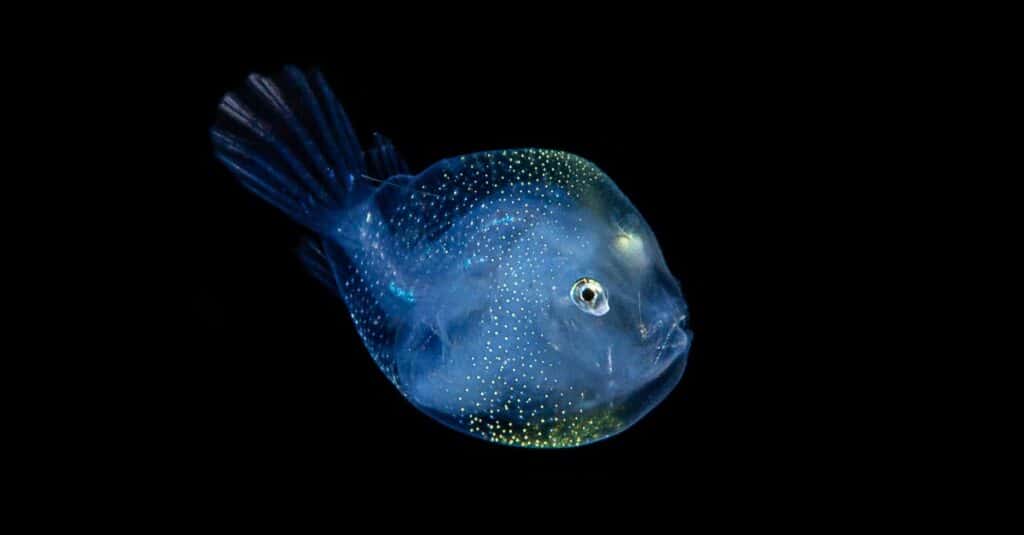
Mount Everest would fit inside the Mariana Trench. the ocean’s deepest point.
©DOERS/Shutterstock.com
Have you heard about the Mariana Trench? It’s the deepest part of the ocean, and there are a lot of scientists that still don’t know about it. As the name suggests, it’s an ocean trench, one of 50 in the world.
Ocean trenches are more than just deep depressions in the ocean. They have a lot of benefits, and some unique animals live in the depths of these trenches. If you want to know more, keep reading.
What Is an Ocean Trench?

Ocean trenches are deep gouges in the earth underneath the ocean.
©iStock.com/ratpack223
Ocean trenches are the deep and sudden trenches in the ocean. They make up the deepest parts in the entirety of the ocean. Usually, ocean trenches are located near subduction zones. These are the zones where two tectonic plates meet and one starts to bend underneath the other. On occasion, ocean trenches can be near convergent boundaries as well. This is simply an area where two tectonic plates are moving towards one another.
On average, these trenches reach depths over 32,800 feet below sea level. The deepest ocean trench known to date is the Mariana Trench. This one measures 35,840 feet below sea level and is considered the deepest point of the ocean. There are other trenches as well, such as the Peru-Chile Trench, the Tonga Trench, and the Kermadec Trench.
Trench or Trough?
It’s important to note that there is another underwater depression called troughs. Though they sound similar, they are quite different. Troughs are usually long depressions with flat bottoms and very steep sides. While trenches also have steep sides, they are more of a V-shape, which means their bottoms get narrower and narrower before tapering off to a point.
There are times when they overlap and there is some confusion. Sometimes, trenches get filled in, so they look like they have a flat bottom. An example of this is the Makran Trough. Some trenches get filled in over time and are no longer called a trench.
Sometimes, their location is what determines whether it is a trench or a trough. Trenches are mostly in subduction zones. If they are in different zones, like a transform fault zone, or they are part of a basin, they aren’t considered trenches and are instead called troughs.
How Are Ocean Trenches Created?
Ocean trenches occur the most near where tectonic plates form because their collisions are what create trenches. Instead of making volcanoes, where the earth rises, the two plates, or just one of the plates, start to sink instead.
The creation of an ocean trench is usually associated with earthquakes and tsunamis, as the force of two plates connecting can also cause the ground to shake.
How Many Ocean Trenches Are There?
It’s thought that there are about 50 ocean trenches in the world. Together, they make up about half a percent of the ocean. This equates to about 733,000 square miles of the ocean focused on trenches.
Are Ocean Trenches Important?

From the surface, there isn’t much to see when it comes to ocean trenches.
©Richard Varcoe on behalf of Caladan Oceanic LLC, CC BY-SA 4.0, via Wikimedia Commons – License
You may be thinking that there isn’t much to note about deep trenches on the ocean floor, but you’d be wrong. These furrows under the ocean floor do quite a lot.
Not only are they home to animals with very specific habitat needs that can’t be met anywhere else under the ocean, but ocean trenches help with the natural cycles of the earth.
Geological Processes
For one, they help to show the earth’s geological processes. They also help with the cycling of minerals in the earth. As trenches are formed, the crust of the earth gets pushed deeper under the ocean. When it gets close enough to the center of the earth, the crust melts and turns into lava. Eventually, that lava will make it back to the surface of the earth via a volcano and create a new layer.
As layers in the crust are formed, it creates the potential to uncover new mineral and ore deposits. While there’s still no practical way to get to these deposits, eventually there might be. This means that currently, limited and expensive minerals might eventually be much cheaper and easier to access. Especially necessary minerals needed to power today’s technology like copper and lithium.
Nutrient Trapping
Ocean trenches also play a role in trapping nutrients and carbon. Because of the unique characteristics of an ocean trench, such as very low temperatures and high levels of pressure, these ocean trenches create areas that hold onto carbon and cycle nutrients.
Evolution
Finally, ocean trenches are the perfect place to study marine evolution. Because animals that live in these areas are adapted to deep water and high pressures, they aren’t able to leave the trenches and migrate. That means, that even if the same animals live in every ocean trench, they will be genetically different from each other over time since they are separated physically from each other.
This offers a great opportunity for scientists to study evolutionary changes happening in real-time and compare animals in each trench to each other and marine animals in lower-pressure habitats.
Many of the animals have unique appearances as well. Some fish have clear heads so they can see animals above them. Others haven’t changed their appearance in millions of years, known as living fossils.
Since food is limited, animals have to develop unique evolutionary changes to survive as well. There are worms in the depths of the ocean that have adapted to burrowing into bones and eating the lipids inside.
There are many animals that have unique features that scientists haven’t yet determined the use of, such as goblin sharks and the long protrusion from the front of their heads.
Animals That Live in Ocean Trenches

Deep sea anglerfish look a little different than the ones in shallower waters.
©Sam Robertshaw/Shutterstock.com
You may not think that many animals could live at such extreme depths. However, there are quite a few animals that have adapted to such harsh environments.
Extensive research into these trenches hasn’t been done yet, which means the total animals that live at these depths haven’t been uncovered. However, scientists have found quite a few animals already that live in the depths.
Some animals that live in ocean trenches include:
- Snailfish
- Anglerfish
- Cusk Eels
- Isopods
- Polychaete Worms
- Amphipods
- Vampire Squid
- Sea Cucumber
- Dumbo Octopus
- Telescope Octopus
- Zombie Worms
- Barreleye Fish
More About the Animals That Make Ocean Trenches Their Home
Some of these animals are similar to ones you might see at shallower levels, such as the anglerfish. Others are quite ancient, like the frilled shark. The frilled shark is a species that has been around for over 80 million years.
Some of the animals in trenches are impossible to get a good picture of. Taking samples does no good, as many animals forced into less pressure after living in the deep tend to balloon up. A good example of this is the blobfish. They were thought once to just be really ugly and blobby fish, but later research determined that they actually lost the structural support their bodies received from the intense pressure under the water.
They ended up looking drastically different above water than they did underwater. While this may create an opportunity to understand more about deep sea evolution, it doesn’t allow for very accurate images of the animals.
Sometimes, scientists get lucky and an animal swims right in front of the camera and bright light, allowing the chance for a fairly clean picture. Unfortunately, that luck is few and far between. This is why, if you come across images of deep-sea animals, some are nothing more than sketches.
The photo featured at the top of this post is © Damsea/Shutterstock.com
Thank you for reading! Have some feedback for us? Contact the AZ Animals editorial team.






